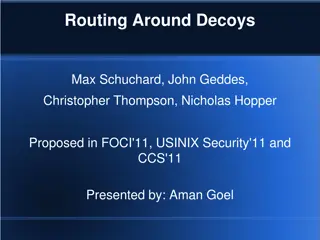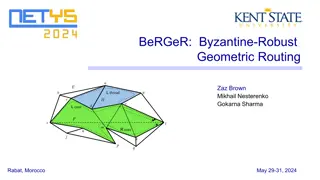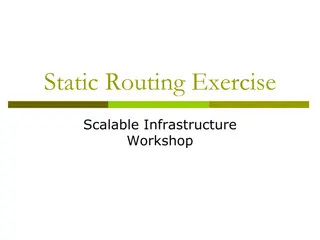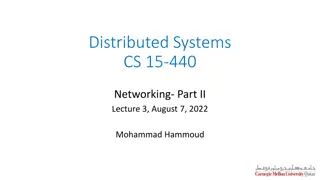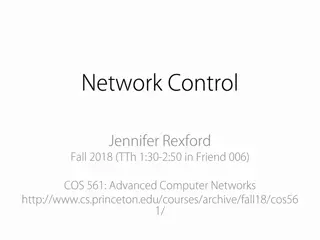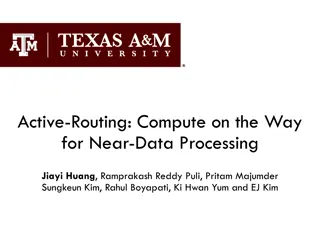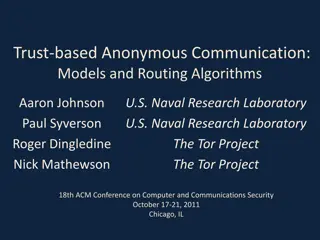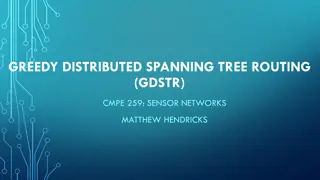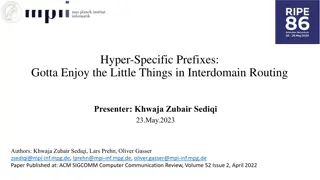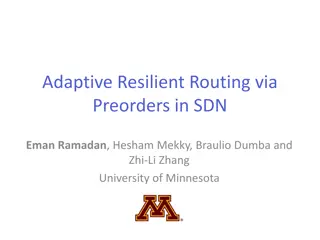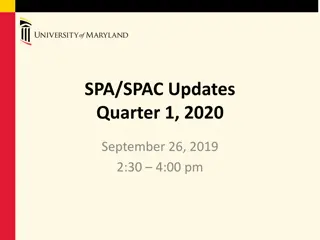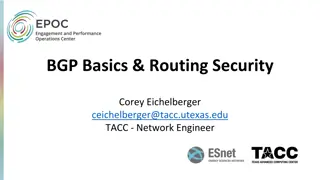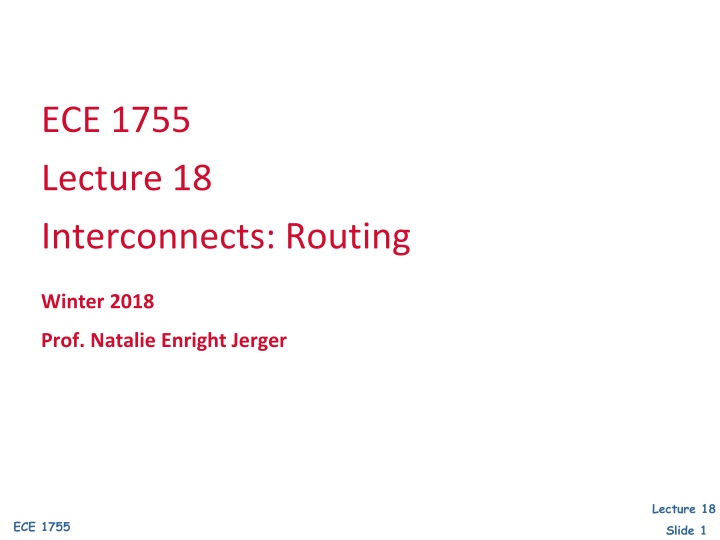
Interconnects and Routing in Winter 2018: Lecture Insights on Dimension Order Routing
Explore the intricacies of routing algorithms, topology, and flow control in interconnects as discussed in a lecture series. Topics cover routing basics, algorithm attributes, deadlock prevention, types of routing algorithms, and a focus on Dimension Order Routing (DOR) also known as X-Y Routing. Understand the pros and cons of deterministic routing and gain insights into optimizing traffic distribution and avoiding hotspots.
Download Presentation

Please find below an Image/Link to download the presentation.
The content on the website is provided AS IS for your information and personal use only. It may not be sold, licensed, or shared on other websites without obtaining consent from the author. If you encounter any issues during the download, it is possible that the publisher has removed the file from their server.
You are allowed to download the files provided on this website for personal or commercial use, subject to the condition that they are used lawfully. All files are the property of their respective owners.
The content on the website is provided AS IS for your information and personal use only. It may not be sold, licensed, or shared on other websites without obtaining consent from the author.
E N D
Presentation Transcript
ECE 1755 Lecture 18 Interconnects: Routing Winter 2018 Prof. Natalie Enright Jerger Lecture 18 Slide 1 ECE 1755
Topics to be covered Interfaces Topology Routing Flow Control Router Microarchitecture Lecture 18 Slide 2 ECE 1755
Routing Lecture 18 Slide 3 ECE 1755
Routing Overview Discussion of topologies assumed ideal routing In practice Routing algorithms are not ideal Goal: distribute traffic evenly among paths Avoid hot spots, contention More balanced closer throughput is to ideal Keep complexity in mind Lecture 18 Slide 4 ECE 1755
Routing Basics Once topology is fixed Routing algorithm determines path(s) from source to destination Lecture 18 Slide 5 ECE 1755
Routing Algorithm Attributes Types Deterministic, Oblivious, Adaptive Number of destinations Unicast, Multicast, Broadcast? Adaptivity Oblivious or Adaptive? Local or Global knowledge? Minimal or non-minimal? Implementation Source or node routing? Table or circuit? Lecture 18 Slide 10 ECE 1755
Routing Deadlock A B D C Each packet is occupying a link and waiting for a link Without routing restrictions, a resource cycle can occur Leads to deadlock Lecture 18 Slide 11 ECE 1755
Types of Routing Algorithms Lecture 18 Slide 12 ECE 1755
Deterministic All messages from Source to Destination traverse the same path Common example: Dimension Order Routing (DOR) Message traverses network dimension by dimension Aka XY routing Cons: Eliminates any path diversity provided by topology Poor load balancing Pros: Simple and inexpensive to implement Deadlock-free Lecture 18 Slide 13 ECE 1755
Dimension Order Routing a.k.a X-Y Routing Traverse network dimension by dimension Can only turn to Y dimension after finished X Lecture 18 Slide 14 ECE 1755
Destination-Tag Routing: Butterfly Networks 1 0 1 Destination address Interpreted as an n-digit radix-k number Directly routes packet 0 0 00 10 20 1 1 2 2 01 11 21 3 4 3 4 Each digit selects the output port at each step 02 12 22 5 5 6 7 6 7 03 13 23 2-ary 3-fly Lecture 18 Slide 15 ECE 1755
Oblivious Routing decisions are made without regard to network state Keeps algorithms simple Unable to adapt Deterministic algorithms are a subset of oblivious Lecture 18 Slide 17 ECE 1755
Valiants Routing Algorithm To route from s to d Randomly choose intermediate node d Route from s to d and from d to d. d Randomizes any traffic pattern All patterns appear uniform random Balances network load d Non-minimal Destroys locality s Lecture 18 Slide 18 ECE 1755
Minimal Oblivious Valiant s: Load balancing but significant increase in hop count Minimal Oblivious: some load balancing, but use shortest paths d must lie within min quadrant 6 options for d Only 3 different paths d s Lecture 18 Slide 21 ECE 1755
Minimal Oblivious Routing on Fat Tree 0 1 000X Node labels (addr template) 00X X 0XXX A XXXX A 2 3 All nodes reachable from left terminals 001X 4 5 010X Route from s to d 01X X 0XXX B XXXX B 6 7 Randomly selected, nearest common ancestor x of s and d 011X 8 9 Route s to x then x to d 100X 10X X 1XXX A XXXX C Example s = 1, d = 6 A B 101X Construct route incrementally C D 110X Randomly select output port 11X X 1XXX B XXXX D Until addr template matches d E F 111X Lecture 18 Slide 22 ECE 1755
Oblivious Routing Valiant s and Minimal Adaptive Deadlock free When used in conjunction with X-Y routing Randomly choose between X-Y and Y-X routes Oblivious but not deadlock free! Lecture 18 Slide 23 ECE 1755
Adaptive Exploits path diversity Uses network state to make routing decisions Buffer occupancies often used Coupled with flow control mechanism Local information readily available Global information more costly to obtain Network state can change rapidly Use of local information can lead to non-optimal choices Can be minimal or non-minimal Lecture 18 Slide 24 ECE 1755
Minimal Adaptive Routing d s Local info can result in sub-optimal choices Lecture 18 Slide 25 ECE 1755
Non-minimal adaptive Fully adaptive Not restricted to take shortest path Generally undesirable to increase path length Necessary for fault tolerance Misrouting: directing packet along non-productive channel Priority given to productive output Some algorithms forbid U-turns Livelock potential: traversing network without ever reaching destination Mechanism to guarantee forward progress Limit number of misroutings Lecture 18 Slide 26 ECE 1755
Non-minimal routing example d d s s Livelock: continue routing in cycle Longer path with potentially lower latency Lecture 18 Slide 27 ECE 1755
Adaptive Routing Example 0 1 2 3 4 5 6 7 Should 3 route clockwise or counterclockwise to 7? 5 is using all the capacity of link 5 6 Queue at node 5 will sense contention but not at node 3 Backpressure: allows nodes to indirectly sense congestion Queue in one node fills up, it will stop receiving flits Previous queue will fill up If each queue holds 4 packets 3 will send 8 packets before sensing congestion Lecture 18 Slide 28 ECE 1755
Congestion Information Local Information about my neighbors only Implicitly available I know how many downstream buffers are available (from flow control) Global Information about all nodes Explicitly send status information Usually based on VC utilization or buffer occupancy Timeliness Lecture 18 Slide 29 ECE 1755
Sending Congestion Information Piggybacking Send congestion information along with packets Extra side network More affordable in on-chip networks Broadcast Packetize Aggregate or individual node Lecture 18 Slide 30 ECE 1755
Adaptive Routing: Turn Model DOR eliminates 4 turns N to E, N to W, S to E, S to W No adaptivity Some adaptivity by removing 2 of 8 turns Remains deadlock free (like DOR) West first Eliminates S to W and N to W West first Lecture 18 Slide 31 ECE 1755
Turn Model Routing Deadlock What about eliminating turns NW and WN? Not a valid turn elimination Resource cycle results Lecture 18 Slide 34 ECE 1755
Adaptive Routing and Deadlock Option 1: Eliminate turns that lead to deadlock Limits flexibility Option 2: Allow all turns Give more flexibility Must use other mechanism to prevent deadlock Rely on flow control (later) Escape virtual channels Lecture 18 Slide 35 ECE 1755
Routing Algorithm Implementation Lecture 18 Slide 40 ECE 1755
Routing Implementation Source tables Entire route specified at source Avoids per-hop routing latency Unable to adapt dynamically to network conditions Can specify multiple routes per destination Give fault tolerance and load balance Support reconfiguration (not specific to topology) Lecture 18 Slide 41 ECE 1755
Source Table Routing Destination Route 1 Route 2 00 X X 10 EX EX 20 EEX EEX 01 NX NX 11 NEX ENX 21 NEEX ENEX 02 NNX NNX 12 ENNX NNEX 22 EENNX NNEEX (0,0 ) 03 NNNX NNNX 13 NENNX ENNNX 23 EENNNX NNNEEX Arbitrary length paths: storage overhead and packet overhead Lecture 18 Slide 42 ECE 1755
Node Tables Store only next direction at each node Smaller tables than source routing Adds per-hop routing latency Can adapt to network conditions Specify multiple possible outputs per destination Select randomly to improve load balancing Lecture 18 Slide 43 ECE 1755
Node Table Routing To From 00 01 02 10 11 12 20 21 22 00 X |- N | - N | - E | - E | N E | N E | - E | N E | N 01 S | - X | - N | - E | S E | - E | N E | S E | - E | N 02 S | - S| - X | - E | S E | S E | - E | S E | S E | - 10 W|- W|- W|- X | - N | - N | - E | - E | N E | N 11 W|- W|- W|- S | - X | - N | - E | S E | - E | N (1,0) 12 W|- W|- W|- S | - S | - X | - E | S E | S E | - 20 W|- W|- W|- W|- W|- W|- X | - N | - N | - 21 W|- W|- W|- W|- W|- W|- S | - X | - N | - Implements West-First Routing 22 W|- W|- W|- W|- W|- W|- S | - S | - X | - Each node would have 1 row of table Max two possible output ports Lecture 18 Slide 44 ECE 1755
Implementation Combinational circuits can be used Simple (e.g. DOR): low router overhead Specific to one topology and one routing algorithm Limits fault tolerance Tables can be updated to reflect new configuration, network faults, etc Lecture 18 Slide 45 ECE 1755
Circuit Based sx x sy y =0 =0 Productive Direction Vector exit +y +x -y -x Queue lengths Route selection Selected Direction Vector exit +y +x -y -x Next hop based on buffer occupancies Or could implement simple DOR Fixed w.r.t. topology Lecture 18 Slide 46 ECE 1755
Routing Algorithms: Implementation Routing Algorithm Source Routing Combinational Node Table Deterministic DOR Yes Yes Yes Oblivious Valiant s Yes Yes Yes Minimal Yes Yes Yes Adaptive No Yes Yes Lecture 18 Slide 47 ECE 1755
Routing Summary Latency paramount concern Minimal routing most common for NoC Non-minimal can avoid congestion and deliver low latency To date: NoC research favors DOR for simplicity and deadlock freedom On-chip networks often lightly loaded Only covered unicast routing Recent work on extending on-chip routing to support multicast Lecture 18 Slide 48 ECE 1755




